“Thank you for sending this copy of your blog about the connection between the Folgers and Captain Robinson. I enjoyed reading it, and their interaction is a delightful one, clearly appreciated by both parties. The letter makes the inscription in the book so much more meaningful than just having the inscribed book alone. It is certainly special to you to have both the book and the letter. “
Anna Dworken
APRIL 23, 2022 IS WILLIAM SHAKESPEARE’S BIRTHDAY!
In no one’s book is one’s 458th birthday a barn burner.
From 2014 to through 2019, I gave 82 talks on my biography of the founders of the Folger Shakespeare Library, Collecting Shakespeare: The Story of Henry and Emily Folger, published by Johns Hopkins University Press. 2014 marked the Bard’s 450th birthday; that year I gave 42 Folger talks. 2016 represented the Bard’s 400th birthday, when I gave 16 Folger talks.
I will celebrate the 458th birthday in 2022 with a blog post featuring a Shakespeare play (Othello), a Shakespeare collector (Henry Folger), and a British sea captain, John Robinson, who memorized vast quantities of the canon and was convinced that Shakespeare was “an admirable and experienced sailor.”
After a Folger talk in 2915 at The Grolier Club in New York City, a member, James Cummins, came up to me and let it be known that his rare book shop carried a book that Henry Folger had inscribed to a friend. Was I interested in buying it for $100? I passed.
However, when out of the blue in February 2022, a bookseller named Alan Winter in Essex, England emailed me to offer a (different) book Folger had inscribed to a friend, along with a manuscript letter to that friend, I expressed interest. The seller accepted my bid of $275.
I never spent so much money on a book before. But it wasn’t really the book I sought; it was more the dated Henry Folger note to Capt. John Robinson that came with it. For 15 years, I had been fascinated by the friendship that had developed between the Robinsons and the Folgers. The best way for the reader to understand my interest in Alan Winter’s proposed items is to read the post published in Folger Shakespeare Library’s research blog The Collation on June 23, 2020 as Covid 19 came rolling in. In it, you will be able to contemplate these images:
Fig. 1. Magazine photo of Capt. John Robinson in uniform, 1905 (Folger archives)
Fig. 2. Stereoscopic photo of Capt. John Robinson at sea, 1906 (Folger archives)
Fig. 3 “Handy” Shakespeare editions Folgers took on ocean voyages (Folger archives)
Fig. 4. Four picture postcards, one envelope from Robinson to Folger, 1909 (Folger archives)
Fig. 5. Photo Robinson sent Folger of him in his garden in Watford, Herts (Folger archives)
Fig. 6. Atlantic Transport Line schedule, 1910 (Grant archives)
Fig. 7. Three-page letter from Capt. John Robinson to Henry Folger, 1910 (Grant archives)
Here’s how the book and note purchase happened. . .
On Monday, Feb. 7, 2022, at 9:20 AM, my webmistress and I received an email from an Alan Winter with an offer. “Hi Stephen. I have a copy of an excellent condition first edition 1886 copy of a new variorum vol v1 edited by Horace Furness) Othello personally inscribed by Mr and Mrs Folger to Capt Robinson dated Sept 1st 1907. I also have a personal letter, on headed Folger notepaper, to Capt Robinson thanking him for the best ever trip on the Minnihaha, and asking that Capt Robinson accept this copy of Othello, as he saw that this title was missing from Capt Robinson’s bookshelves. Would you be interested in purchasing this, or if not have you contact details for relatives of Capt Robinson’s who may be interested in purchasing it? More details and photos if required. Thank you. Alan WINTER”
On Feb 10, a second message from Winter soon followed. “Thank you for your quick response and interest. I am keen that this item goes to someone who can appreciate it’s historical context, rather than just eBay it. It is a small but remarkable piece of personal history. A heartfelt and thoughtful gift with a very personal note. They must have been very good friends. I bought the book in eBay amongst nine other Shakespeare books so I have no knowledge of its recent history. All of the other books bought were handsomely illustrated, but as you will know, that is not the case with the new variorum edition of Othello. It came from a private library so presumably the deceased library owner recognized the value of the letter and the book together, and that was why he bought the item. It is amazing that the letter has stayed with the book. The book was not advertised and was simply one of nine that helped mask the book I actually wanted, which was a leather bound first edition copy of a Midsummer Night’s Dream, illustrated by Arthur Rackham.”

Fig. 1
Package from Essex, England arrived in Arlington, Va.
Photo by Stephen Grant
We agreed on a price through eBay and I paid. The bookseller in Essex, England posted the materials via the Royal Mail. The whole operation took exactly a month.
My opening the packaging around the book made me think of the Folgers opening hundreds of book packages in their basement at 24 Brevoort Place in the Bedford-Stuyvesant section of Brooklyn.
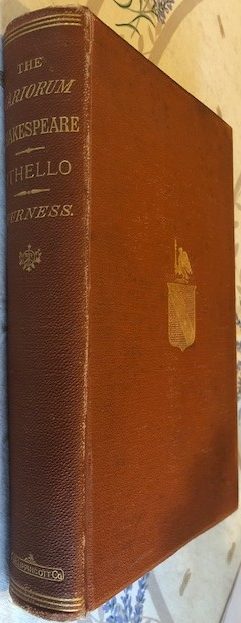
Fig. 2
VARIORUM SHAKESPEARE OTHELLO FURNESS JB LIPPINCOTT CO.
Photo by Stephen Grant
The book was copyright in 1886 by the J. B. Lippincott Company in Philadelphia and contains 471 pages. It measures 7×10 in. and weighs 3.4 lbs.
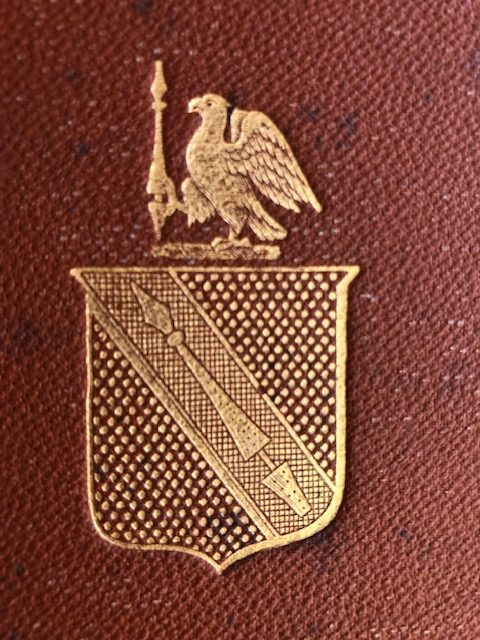
Fig. 3
Shield on pebble-grain cloth binding
Photo by Stephen Grant
The book has a typical trade or publisher’s binding from the late 19th century. It is bound in a popular cloth at the time, a pebble grain, starch impregnated cloth, stamped in gold. A shield is blocked or stamped on the front cover. The book is in good condition and shows little sign of use. I never before owned a book with a pebble-grain binding. I picked up the habit of running my thumb over the book when I passed by it on a mahogany table in my bedroom.
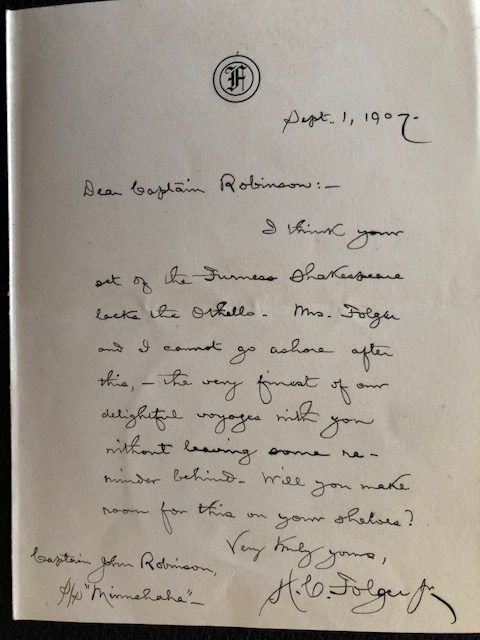
Fig. 4
Handwritten note from Henry Folger to Capt. John Robinson, Sept. 1, 1907
Photo by Stephen Grant
Dear Captain Robinson:–
I think your set of the Furness Shakespeare lacks the Othello. Mrs. Folger and I cannot go ashore after this,– the very finest of our delightful voyages with you without leaving some reminder behind. Will you make room for this on your shelves?
Very truly yours,
H. C. Folger Jr.
Captain John Robinson,
SS “Minnehaha” –
Henry Clay Folger in his correspondence is the epitome of courtesy and refinement. He has traveled across the Atlantic with stationary embossed with the letter “F.” Folger has taken the pains to carefully look over the Shakespeare volumes he had been sending the good captain over the years that lay on the shipmaster’s shelves and noticed the absence of the Othello Variorum. Henry qualifies the latest crossing in superlative terms; with a wink he asks how the Folgers could possibly leave shipboard without remedying the situation.
I quote two paragraphs from Collecting Shakespeare to provide the reader with additional information concerning the close Folger-Robinson relationship:
On Good Friday every year, the Folgers traveled to Wallingford, Pennsylvania, for a short visit to the Furnesses for what their host jokingly called “endless Shakespeare gossip.” The visits always included Shakespeare readings and commentary by the erudite Furness that would leave Folger spellbound. The two couples looked forward to these visits as the social and intellectual apex of their year. Helen Furness had published a book on Shakespeare’s poetry. Before he died in 1912, Horace Howard Furness edited eighteen of the plays in “variorum” editions—that is, volumes providing copiously annotated texts filled with critical commentary spanning generations. When the Folgers walked up the front lawn, Furness burst out the door to blast a welcome on his trumpet. He thanked Emily for the poems she had sent him. One of Furness’s many letters to Emily—posted in small white envelopes sealed in black wax—read, “The picture you draw of working with your husband moves me deeply.” After the guests settled in, Furness proudly showed off some recent acquisition or improvement, such as a new fireproof room to house their valuables. After dinner, the two couples repaired to the library of 12,000 volumes on Elizabethan drama for deep discussion. Folger visits to the Furnesses brought alive the past. In the late 1880s, before they had met Furness, Emily and Henry had copied in their commonplace books Shakespearean commentary by Furness to ponder and discuss. One line read, “If there is one quality in which Shakespeare is forever Shakespeare, it is in the unity of his characters, in the thorough individuality, in the absolute truth to themselves.” Furness had become mentor and friend to an inner circle of Shakespeare worshipers. When Furness died, he was holding a rare Shakespeare volume he had had specially bound as a gift to the Folgers (Collecting Shakespeare, pp. 36–37).
One Christmas, Captain Robinson gave the Folgers his painting of Anne Hathaway’s cottage. Touched by the gesture, Folger assured the captain that the painting hung in honorable company in the Folger house: “You may guess how satisfactory the painting is when I tell you that it has been hung over Hayman’s portrait of Quinn as Falstaff, painted from life and used as the basis of the well-known engraving, and at right angles to Sir Joshua Reynolds’s portrait of Garrick.” The Folgers sent Robinson a complete set of the Furness variorum editions of Shakespeare. They gave Captain Robinson and his family seeds from Shakespeare’s garden in Stratford, and Renee Robinson offered Emily poppy seeds to take back to America. A special treat for the Robinsons occurred when they motored from their residence in the northwest London suburb of Watford to Stratford-upon-Avon as guests of the Folgers to attend a Shakespeare performance (Collecting Shakespeare, p. 38–39).

Fig. 5
Front endpaper
Photo by Stephen Grant
Alan Winter may have purchased the copy of Othello from a bookdealer who purchased part of the Alan Carr Library in London. Alan Carr’s bookplate is affixed to the endpaper at the beginning of the book.

Fig. 6
Front flyleaf
Photo by Stephen Grant
Opposite the endpaper is the flyleaf on which is written in pencil at the top, “First Edition – published April 10, 1886 –. Underneath Henry Folger wrote in pen the following inscription:
Captain John Robinson,
S/S “Minnehaha.”
with the sincere regards of
Mr. & Mrs. H. C. Folger Jr.
Sept 1, 1907–

Fig. 7
Book Price
Photo by Stephen Grant
On the back of the flyleaf is written in pencil the price of the book at one point: £3.
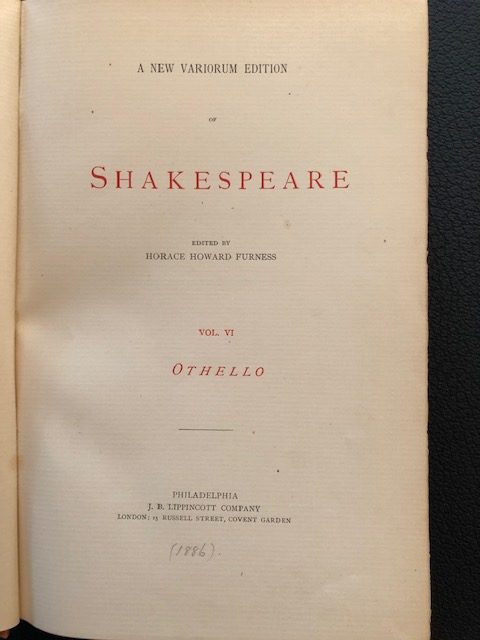
Fig. 8
Title page
Photo by Stephen Grant
The title page is printed in black and red type. At the bottom is added in pencil, (1886). The J. B. Lippincott Company in Philadelphia was founded in 1836. The sixth Shakespeare variorum volume, Othello, was published in 1886, the year the Lippincott founder, Joshua Ballinger Lippincott, died.

Fig. 9
Back flyleaf
Photo by Stephen Grant
On the back flyleaf, the price of the book at another point is marked in pencil as 5/, or five shillings.
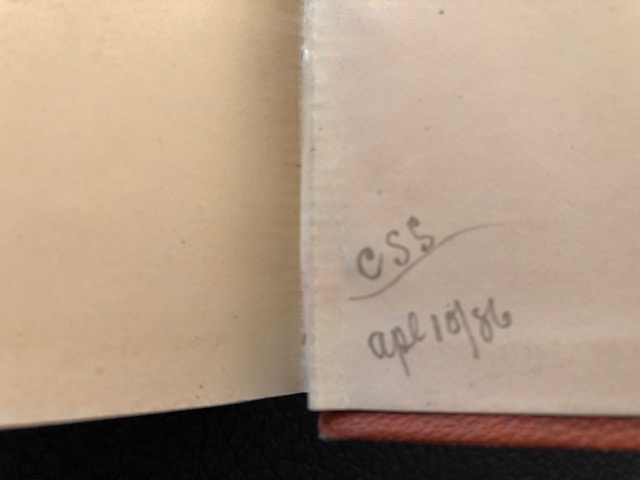
Fig. 10
Back endpaper
Photo by Stephen Grant
On the back endpaper at the bottom is written, “CSS” and underneath, “ape 10/86.”
Capt. John Robinson retired from his maritime career in 2007 due to poor eyesight.
I would welcome comments at the end of this blog post regarding interpretation of any aspects of images or text. Happy Birthday, Will!
COMMENTS:
3 Comments
Submit a Comment
CONNECT

A great find!
Thank you for sending this copy of your blog about the connection between the Folgers and Captain Robinson. I enjoyed reading it, and their interaction is a delightful one, clearly appreciated by both parties. The letter makes the inscription in the book so much more meaningful than just having the inscribed book alone. It is certainly special to you to have both the book and the letter.
A little 5 bob ditty!